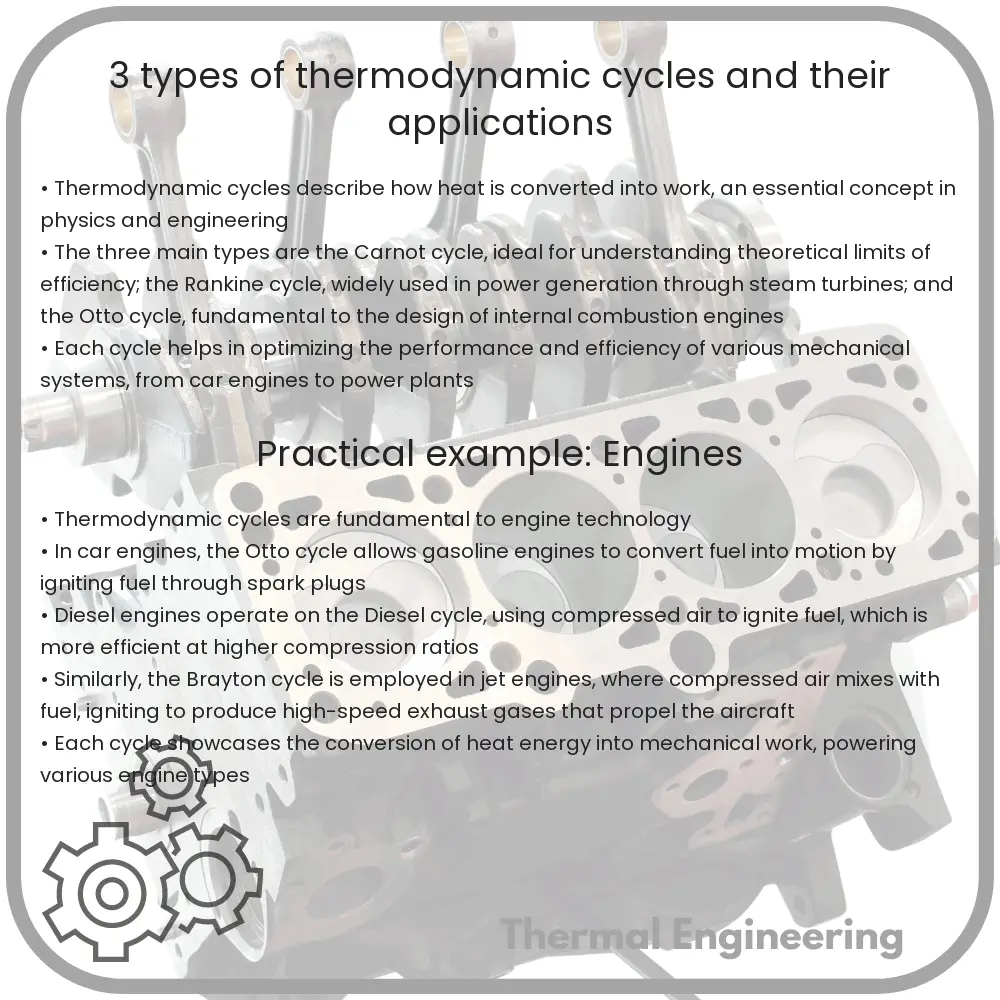Learn about thermodynamic cycles, essential processes in engineering systems like engines and refrigerators, exploring types like Carnot, Rankine, and Brayton cycles.

Understanding Thermodynamic Cycles
Thermodynamic cycles are processes that involve heat and work transferring in and out of systems, typically interpreted through a series of thermodynamic processes that return a system to its initial state. These cycles are fundamental to the operation of many engineering systems, including engines and refrigerators. In this article, we will explore three significant types of thermodynamic cycles and their applications in real-world devices.
Carnot Cycle
The Carnot cycle is a theoretical thermodynamic cycle proposed by Nicolas Léonard Sadi Carnot. It is considered the most efficient cycle for converting a given amount of thermal energy into work or vice-versa. The cycle has four reversible processes: two isothermal (constant temperature) and two adiabatic (no heat exchange).
- Isothermal Expansion: The system (usually a gas) expands at constant temperature by absorbing heat from a high-temperature reservoir.
- Adiabatic Expansion: The system expands without any heat exchange, which drops its temperature and pressure.
- Isothermal Compression: The system is compressed at a lower constant temperature, releasing heat to a low-temperature reservoir.
- Adiabatic Compression: Compression occurs without heat exchange, increasing the system’s temperature and pressure back to its original state.
The Carnot cycle is used primarily as an ideal standard against which the actual performance of heat engines can be compared. Its efficiency, given by \( \eta = 1 – \frac{T_{\text{cold}}}{T_{\text{hot}}} \) where \( T_{\text{cold}} \) and \( T_{\text{hot}} \) are the temperatures of the cold and hot reservoirs, respectively, signifies the maximum possible efficiency that any heat engine can achieve operating between these two reservoirs.
Rankine Cycle
The Rankine cycle is used extensively in power generation, especially in steam-powered engines found in thermal power plants. It mirrors many steps of the Carnot cycle but uses a pump and steam turbine for the working of the cycle.
- Pumping: Liquid water is pumped from a low to a high pressure, raising its temperature.
- Boiling and Superheating: At high pressure, the water is heated in a boiler, turning it into steam and then superheated beyond its boiling point.
- Expansion through Turbine: The superheated steam expands through a turbine, producing work by rotating the turbine’s blades.
- Condensation: The steam leaves the turbine, enters a condenser, and is condensed back into liquid water by releasing its heat to the surrounding environment.
The work done by the turbine generates most of the electrical power while the pump consumes a part of this work, reflecting an overall conversion of heat to work. The efficiency improvements in the Rankine cycle have been primarily focused on increasing the temperature and pressure limits of the steam.
Brayton Cycle
The Brayton cycle (or Joule cycle) depicts the workings of a gas turbine engine, which is commonly used in aircraft engines and power plants. It consists of three main processes:
- Compression: Air is compressed in a compressor, increasing pressure and temperature.
- Combustion: Fuel is injected and combusted at constant pressure, greatly increasing the temperature and expanding the air.
- Expansion: The high-temperature, high-pressure air expands through a turbine, creating work that propels the compressor and may drive an additional output such as an electrical generator.
This cycle is known for its ability to produce a high power output at high efficiencies and is favored in settings where size and responsiveness are critical.
The applications of these thermodynamic cycles range from small home appliances like refrigerators and air conditioners to major power generation systems dominating the industrial landscape. Understanding these cycles enables engineers and scientists to innovate and improve upon existing technologies, making energy usage more efficient and sustainable.